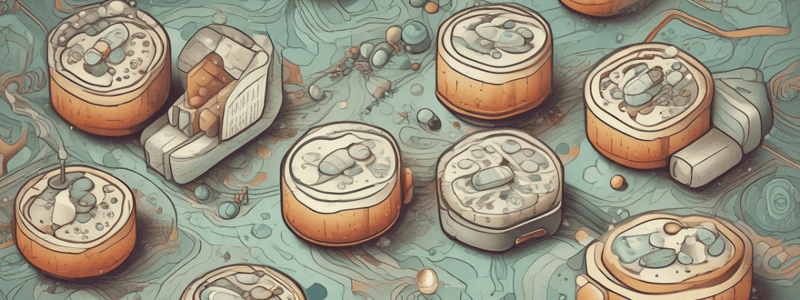Podcast
Questions and Answers
Penicillin là loại thuốc kháng sinh được phát hiện bởi Alexander Fleming vào năm 1928.
Penicillin là loại thuốc kháng sinh được phát hiện bởi Alexander Fleming vào năm 1928.
True (A)
Penicillin ngăn chặn sự tổng hợp thành tế bào của vi khuẩn bằng cách kích hoạt enzym vi khuẩn.
Penicillin ngăn chặn sự tổng hợp thành tế bào của vi khuẩn bằng cách kích hoạt enzym vi khuẩn.
False (B)
Penicillin không gây hại cho tế bào người vì chúng thiếu thành tế bào, nên an toàn khi sử dụng cho con người.
Penicillin không gây hại cho tế bào người vì chúng thiếu thành tế bào, nên an toàn khi sử dụng cho con người.
True (A)
Penicillin được sử dụng để điều trị các loại vi khuẩn như Escherichia coli và Salmonella.
Penicillin được sử dụng để điều trị các loại vi khuẩn như Escherichia coli và Salmonella.
Penicillin có thể được sử dụng để điều trị viêm màng não và sự nhiễm trùng họng.
Penicillin có thể được sử dụng để điều trị viêm màng não và sự nhiễm trùng họng.
Tương tác thuốc với Penicillin không cần được quan tâm do thuốc an toàn khi sử dụng.
Tương tác thuốc với Penicillin không cần được quan tâm do thuốc an toàn khi sử dụng.
Penicillin không có chống chỉ định trong việc sử dụng cho bất kỳ trường hợp nào.
Penicillin không có chống chỉ định trong việc sử dụng cho bất kỳ trường hợp nào.
Cơ lực của Penicillin là ngăn chặn vi khuẩn phân chia và mở rộng thành tế bào mới.
Cơ lực của Penicillin là ngăn chặn vi khuẩn phân chia và mở rộng thành tế bào mới.
Sự phản ứng phụ phổ biến khi sử dụng Penicillin là đau đầu và mệt mỏi.
Sự phản ứng phụ phổ biến khi sử dụng Penicillin là đau đầu và mệt mỏi.
Việc sử dụng Penicillin có thể gây ra tăng cân và huyết áp.
Việc sử dụng Penicillin có thể gây ra tăng cân và huyết áp.
Penicillin G và penicillin V đều có sự ổn định với axit và được sử dụng cho cùng mục đích điều trị.
Penicillin G và penicillin V đều có sự ổn định với axit và được sử dụng cho cùng mục đích điều trị.
Phản ứng phản ứng quá mẫn với penicillin có thể bao gồm phát ban da và phù nề.
Phản ứng phản ứng quá mẫn với penicillin có thể bao gồm phát ban da và phù nề.
Phản ứng sốc phản vệ với penicillin chỉ xảy ra ở những người chưa từng tiếp xúc với penicillin trước đó.
Phản ứng sốc phản vệ với penicillin chỉ xảy ra ở những người chưa từng tiếp xúc với penicillin trước đó.
Penicillin có thể tương tác với các loại thuốc khác như dược chất chống đông và các loại kháng sinh, ảnh hưởng đến hiệu quả hoặc an toàn của thuốc.
Penicillin có thể tương tác với các loại thuốc khác như dược chất chống đông và các loại kháng sinh, ảnh hưởng đến hiệu quả hoặc an toàn của thuốc.
Sự kháng thuốc của một số dòng vi khuẩn có thể do sản xuất β-lactamase, một enzyme phá hủy cấu trúc bên trong của penicillin.
Sự kháng thuốc của một số dòng vi khuẩn có thể do sản xuất β-lactamase, một enzyme phá hủy cấu trúc bên trong của penicillin.
Vi khuẩn đã trở nên kháng penicillin do thiếu điểm tiếp nhận thành tế bào cho penicillin, làm giảm khả năng của nó để xâm nhập vào tế bào vi khuẩn.
Vi khuẩn đã trở nên kháng penicillin do thiếu điểm tiếp nhận thành tế bào cho penicillin, làm giảm khả năng của nó để xâm nhập vào tế bào vi khuẩn.
Vi khuẩn đã trở nên kháng penicillin do sản xuất các loại penicillinase-resistant penicillins.
Vi khuẩn đã trở nên kháng penicillin do sản xuất các loại penicillinase-resistant penicillins.
Khi kê đơn penicillin, chuyên gia y tế cần xác nhận rằng vi khuẩn gây nhiễm trùng là vi khuẩn mà thuốc này có hiệu quả chống lại.
Khi kê đơn penicillin, chuyên gia y tế cần xác nhận rằng vi khuẩn gây nhiễm trùng là vi khuẩn mà thuốc này có hiệu quả chống lại.
Penicillin là một loại thuốc không đủ sức mạnh để ức chế sự phát triển vi sinh và điều trị các nhiễm trùng.
Penicillin là một loại thuốc không đủ sức mạnh để ức chế sự phát triển vi sinh và điều trị các nhiễm trùng.
Penicillin thay đổi cấu trúc bên trong vi khuẩn để ngăn chặn sự phát triển của chúng.
Penicillin thay đổi cấu trúc bên trong vi khuẩn để ngăn chặn sự phát triển của chúng.
Study Notes
Penicillin: The Discovery, Mechanism of Action, Uses, and Side Effects
Discovery of Penicillin
Penicillin is one of the first and most widely used antibiotic agents, discovered by Scottish bacteriologist Alexander Fleming in 1928. He observed that colonies of the bacterium Staphylococcus aureus were inhibited when contaminated with the mold Penicillium notatum ((#the-discovery-and-development-of-penicillin-designated)). This mold produces a substance capable of killing many common bacteria, which Fleming named "penicillin." In the late 1930s, Australian pathologist Howard Florey and British biochemist Ernst Boris Chain isolated and purified penicillin, and by 1941, an injectable form of the drug was available for therapeutic use ((#penicillin---an-overview)).
Mechanism of Action
Penicillin works by inhibiting the bacterial enzymes responsible for cell wall synthesis in replicating microorganisms. By activating these enzymes, penicillin is effective against actively replicating bacteria, such as Staphylococcus aureus and Streptococcus pyogenes. It does not harm human cells, which lack cell walls, making it safe for use in humans ((#penicillin)).
Medical Uses
Penicillin is used to treat a wide range of infections, such as throat infections, meningitis, syphilis, and various other bacterial infections. It is available in different forms, including penicillin G (benzylpenicillin) and penicillin V (phenoxymethylpenicillin), which have different acid stability and are used for different therapeutic purposes ((#penicillin)). Semisynthetic penicillins are also produced, which are more acid-stable and may be given as oral medication ((#penicillin)).
Side Effects
The side effects of penicillin are mainly hypersensitivity reactions, including skin rash, hives, swelling, and anaphylaxis. Severe reactions, such as anaphylactic shock, are rare but can occur in previously sensitized individuals within seconds or minutes. These reactions can be treated with corticosteroids, while anaphylactic shock may require immediate administration of epinephrine ((#penicillin)).
Tương Tác Thuốc (Drug-Drug Interactions)
Penicillin may interact with other medications, such as anticoagulants and other antibiotics, which can affect the efficacy or safety of the drug. It is essential to consult a healthcare professional or pharmacist before combining penicillin with other prescription or over-the-counter drugs ((#penicillin)).
Chống Chỉ Định (Antibiotic Resistance)
Some strains of bacteria have developed resistance to penicillin. This resistance can be due to the production of β-lactamase (penicillinase), an enzyme that disrupts the internal structure of penicillin, or the lack of cell wall receptors for penicillin, reducing its ability to enter bacterial cells. To address this issue, penicillinase-resistant penicillins (second-generation penicillins) have been developed, which are more effective against certain strains of bacteria. However, some strains have also become resistant to these agents, leading to the development of third-generation penicillins with broader spectrums of activity ((#penicillin)).
Chỉ Định (Prescribing Information)
When prescribing penicillin, healthcare professionals should confirm that the underlying infection is likely the result of a bacteria susceptible to the drug. They should also inform patients of any side effects that require immediate attention, such as prolonged diarrhea or a serious rash. In an outpatient setting, communication between clinicians, pharmacists, and nurses is crucial for appropriate drug dispensing and administration ((#penicillin)).
Dược Lực (Potency)
Penicillin is highly potent in terms of its ability to inhibit bacterial growth and treat infections. Its discovery and development have significantly impacted the field of medicine, and it remains an essential tool in the treatment of bacterial infections ((#the-discovery-and-development-of-penicillin-designated)).
Studying That Suits You
Use AI to generate personalized quizzes and flashcards to suit your learning preferences.
Description
Explore the discovery, mechanism of action, medical uses, side effects, drug interactions, antibiotic resistance, prescribing information, and potency of penicillin. Learn about its historical importance and significant impact on medicine.




